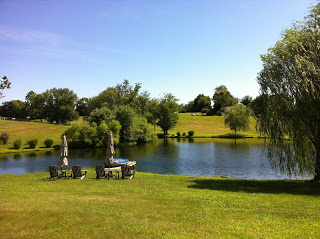By Greg Blackham, Aquatic Specialist
 As summer arrives, many changes take place in your pond, some drastic and others more subtle. The water temperature is quite warm in the upper layers of water closest to the surface; and, if your pond is shallow, the entire water column is warm. All types of aquatic life thrive in this climate: aerobic bacteria, anaerobic bacteria, plants, and most of all pond algae.
As summer arrives, many changes take place in your pond, some drastic and others more subtle. The water temperature is quite warm in the upper layers of water closest to the surface; and, if your pond is shallow, the entire water column is warm. All types of aquatic life thrive in this climate: aerobic bacteria, anaerobic bacteria, plants, and most of all pond algae.
Summer is the easiest time of year to gauge the contamination level of your pond. The spring algae gives way to more competitive and sometimes toxic algae. Blue-green algae, which actually appears in a lot of different colors, despite its name, rears its ugly head. Algae colonize so rapidly that even if you have some type of management in place for your pond, it may not be enough. Most ponds are polluted with excess phosphorous, which is the limiting nutrient in blue-green algae production.
Summer is also the time when you may discover you have an invasive submerged aquatic plant. All spring long these silent invaders have been creeping upwards, and come summer they have reached the surface to flower. After they flower, large masses of dead material will float to the surface and hang around through the winter, eventually decomposing and feeding the growth of new plants and algae.
Fish can also struggle during the warmer months. Generally there is a lot more food circulating through the chain, which can fatten them up nicely, but the bigger they get the more dissolved oxygen they need. Oxygen can be scarce in very warm water as plants and organic matter decompose and bacterial activity heightens. A strong summer thunderstorm can be a catalyst for a fish kill, as the water turns over and the fish get trapped in hypoxic sections of the pond.
Towards the end of summer you may see a surge of planktonic algae. This can look like pea soup or if it is thick enough may even have the look and feel of latex paint. A moderate amount of planktonic algae is not necessarily a bad thing and will usually subside on its own as temperatures start to cool in the fall. It can be unsightly, though, and give the pond a very “scummy” look. Problems with too much planktonic algae can usually be balanced with a healthy dose of beneficial bacteria. Your pond already has some beneficial bacteria, but more may be needed, especially in polluted ponds, or ponds with an abundance of nutrients.
As long as you stay proactive with the management of your pond, it can maintain its spring beauty through the heat of the summer months. Even with management, though, algae can grow so fast in the summer that you might find yourself playing catch up from time to time.
Contact the experts at 888-480-5253 for all of your lake, pond and fisheries management needs.
Greg Blackham is an Aquatic Specialist with SOLitude Lake Management. Since 1998, SOLitude Lake Management has been committed to providing full service lake and pond management services that improve water quality, preserve natural resources, and reduce our environmental footprint. Services are available throughout the Eastern United States. Fisheries management consulting and aquatic products are available nationwide. Learn more about SOLitude Lake Management and purchase products at www.solitudelakemanagement.com.










